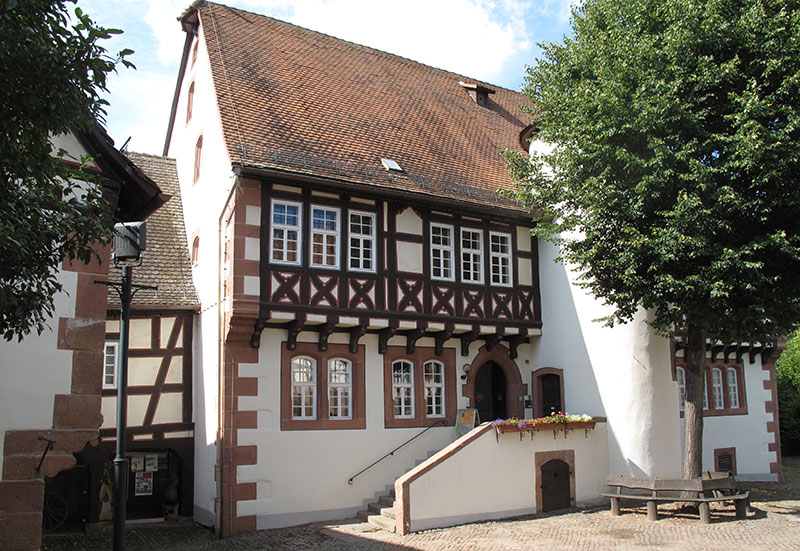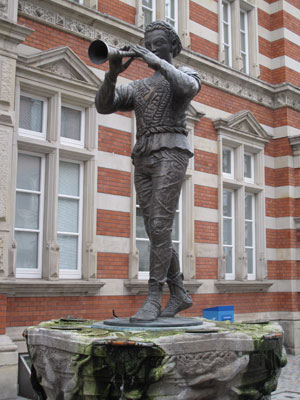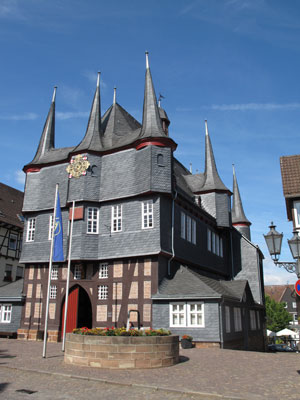Following Germany’s Fairy Tale Route
This item appears on page 42 of the August 2013 issue.
by Ernest Christman; Albuquerque, NM
Driving the German Fairy Tale Route is one way to experience a less traveled but delightful area of Germany. Tourist attractions along the route are primarily associated with the fairy tales found in the publications of the brothers Wilhelm and Jacob Grimm and include locations where they lived and worked at various stages in their lives some 200 years ago.
The route
The route, established in 1975, covers 370 miles and goes from the brothers’ birthplace, Hanau, in central Germany to Bremen in the north.
Having been a student in Germany in the ’50s, I was familiar with the Grimm brothers’ involvement in publishing the first practical German dictionary and works on German grammar as well as with their “Kinder- und Hausmärchen” (“Children’s and Household Tales”), first published in 1812.
In September 2012, my family toured Germany following a 4-day stay in Prague. We took a taxi to Dresden ($150 for three persons — cheaper than first-class train tickets), where we picked up our rented Mercedes. After touring Görlitz, which was split between Germany and Poland at the end of WWII, we went on to Berlin for four days, staying at the magnificent Hilton.
We ended our German journey by touring the southern half of the Fairy Tale Route, starting in Hameln and following it south to the Frankfurt am Main airport, a trip of 197 miles.
The sights
Hameln, the site of the famous Pied Piper legend, is a delightful, traffic-free medieval town. We stayed in a bed-and-breakfast, Hotel Bellevue (Klütstraße 34; www.hotel-bellevue-hameln.de), a 15-minute walk from town. The owners spoke excellent English. Room rates range from €68 ($91), single, to €107 ($143), double.
Dinner was at a midtown tavern, Im Rattendrug, which featured scenes from the Pied Piper legend on its walls.
The legends that are the basis of the fairy tales generally arose from area folklore. Of course, more than one community claims to be the location of one or more of the 211 tales published by the Brothers Grimm.
One memorable site was in the town of Trendelburg. Hotel Burg featured a tower claimed to be the inspiration for the one in the Rapunzel fairy tale, and the manager was pleased to give us a tour of the castle.
The hotel’s restaurant was a superb place for lunch. The three of us had cream-of-mushroom soup, one had a salad, one had dessert and two had coffee for a total price of €28 ($37).
In contrast to Trendelburg’s castle, the Sababurg Sleeping Beauty Castle was a ruin and had a pricey admission fee, which made it not worth a visit other than to enjoy the grounds.
In Frankenberg, we did an overnight at Die Sonne Frankenberg hotel (Marktplatz 2-4), a luxury establishment that was worth the price, as was their restaurant. Our one-night stay in one double and one single room, including breakfast and gourmet dinner with wine, cost €482 ($632). The medieval town boasts a superbly preserved town hall adjacent to the hotel.
At the hotel, we were offered free use of an Audi S7 (list price, about $90,000!) to peruse the area. We drove to Waldeck Castle, where we enjoyed coffee on the veranda and the superb view. This castle had a modern, expensive hotel that we deemed less appealing than the Sonne Frankenberg. It did have a medieval dungeon of some minor interest.
The Grimm legacy
Another stop was Kassel to see the Brothers Grimm Museum, which houses a large collection of their published academic works in addition to many editions of their fairy tales. Photography was prohibited inside the museum.
We stayed at the Kurpark Hotel (Wilhelmshöher Alee 336), a trolley ride away from the town center. It had an adequate restaurant (dinner for three cost €98) and they provided a free “guest pass” for unlimited rides on public transportation. Our double and single rooms cost a total of €300.
The town of Steinau was where the Grimm family lived from 1791 to 1796. The original house still stands, partially furnished as it would have been then, and is now a museum displaying their literary works and illustrations of some of the fairy tales. Photography there is prohibited.
Steinau’s castle also had an extensive display of illustrated fairy tales.
There are many interesting sites along this route. The Deutsche Märchenstrasse office (Kurfürstenstraße 9, 34117 Kassel) sent an illustrated brochure describing them in English upon my request.
I’d recommend familiarizing yourself with the major Grimm fairy tales before doing this trip, as much of the signage is in German, though it’s still comprehensible if you’ve read the brochure beforehand. There are also excellent sources on the Web (search “Grimm Fairy Tales”).



